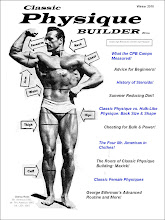

In a previous post, we put forward the basic characteristics of a classic physique: Broad shoulders and chest, narrow waist & hips, straight thighs, and arms, claves, and neck that measure the same. This is a simple description and there is more to than that (e.g., how large should the forearm be in relation to the upper arm, etc) that we shall discuss in future posts. However, this is enough to get us started.
To illustrate the point that people of different heighths and builds can still embody the ideal of a classic physique, we can look at the measurements of two Golden Age bodybuilding champions: John Grimek (Mr. America 1940, 1941, Mr. Universe 1948, Mr. USA 1949) and Steve Reeves (Mr. America 1947, Mr. World 1948, and Mr. Universe 1950). John Grimek was shorter (5'8") and had a relatively thicker bone structure (wrist size = 8.0"). Steve Reeves was taller (6'1") and had a relatively sleeker build (wrist size = 7.9"). Nevertheless, they both illustrate perfectly the characteristics of a classic physique.
Grimek's measures were: neck (17 in), arm (17 in), calves (17 in), chest (47), waist (31 in), thigh (25 in), forearm (14 in), and weight (195 lbs). Reeves measurements were: neck (18.25 in), arm (18.25 in), calves (18.25 in), chest (52 in), waist (29 in), thigh (26 in), forearm (14.75 in), and weight (215 lbs). Notice how the neck, arms, and calves have the same measurement.
Genetics certainly places some constraints on how narrow the waist and hips can be relative to the shoulders and chest. Reeves certainly excels in this area. However, both Grimek and Reeves, being of different heights and builds still embody the ideal of a classic physique. Why? Because they held it as an ideal and trained for symmetry and proportion - not for "freaky size at all costs."
So, when you are in the gym, pay attention to total body symmetry and don't just work the "t-shirt" muscles. There is nothing impressive about having a huge upper body with "toothpick" legs. Think "symmetry" and train to attain it! There is no reason why you can't have the symmetry of a Grimek (above photo: right) or Reeves (above photo: left)!
 Check out our new video clip of George Eiferman. George was Mr. Philadelphia 1947. That year, he also competed in the Mr. America contest against Steve Reeves and came in fifth (Steve won). In 1948, he captured the Mr. America title. The following year, he appeared in a movie called "The Devil's Sleep" and played the part of a gym instructor (see our clip). In 1954, George toured with Mae West as part of a group of musclemen in her nightclub act. In 1962 (the twilight of the Golden Age of Natural Bodybuilding), he won the IFBB Mr. Universe title. He appeared on the cover of many issues of the muscle magazines during the Golden Age of Natural Bodybuilding.
Check out our new video clip of George Eiferman. George was Mr. Philadelphia 1947. That year, he also competed in the Mr. America contest against Steve Reeves and came in fifth (Steve won). In 1948, he captured the Mr. America title. The following year, he appeared in a movie called "The Devil's Sleep" and played the part of a gym instructor (see our clip). In 1954, George toured with Mae West as part of a group of musclemen in her nightclub act. In 1962 (the twilight of the Golden Age of Natural Bodybuilding), he won the IFBB Mr. Universe title. He appeared on the cover of many issues of the muscle magazines during the Golden Age of Natural Bodybuilding. 


































